Precision Hand Loading for Long Range-Chapter One: Brass Sort & Prep
By Tres MonCeret
I have written an instructional article on some of the more advanced techniques of precision hand loading after teaching and answering questions on this subject time and time again. Many of these techniques are basic procedures in competitive bench rest shooting. We field shooters can squeeze all the more accuracy out of our equipment by incorporating many of these procedures even though we are not using zero tolerance rifles. However not ALL bench rest loading techniques nor ways of thinking are desirable for our purposes here as we are not on tidy cement benches, with "glued in" rifles having a specified neck dimensioned chambers and minimal tolerances throughout the weapon. Nor are our rifles or ammo protected entirely from dust, grit, rain as well as beats & bangs if not worse! In the following pages I explain the techniques I adapted from bench best competitive procedure that I feel are worthwhile and beneficial to the typical high-end field rifle & shooter.
Chapter 1: Brass Sort & Prep
Everything we do in hand loading is in the name of consistency, shot to shot. (Technically not "reloading" which is quick & expedient for the likes of short range speed shooting such as IPSC & Steel challenge shoots.)
So there it is before us - a fine specimen of a fired case. We need to resize our cases as well as deprime them. But before we do that, our case has a vital piece of information it's dying to give us.
When we resize the case we want it to stay a precision fit to the individual rifle's chamber from which it was fired. If we go ahead and resize it we have lost this information of the rifle's length of headspace. We need a tool for this.
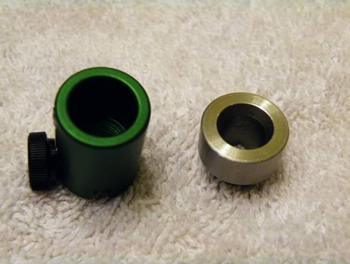
We are going to measure the case from its head (where the writing is) to the datum of the shoulder. For this we need the above illustrated or similar tool from Sinclair International or other supplier. This device holds the insert onto your calipers. You'll also need the insert specific to your cartridge.
Here's a photo of the freshly fired case from the rifle being measured to obtain a headspace measurement:
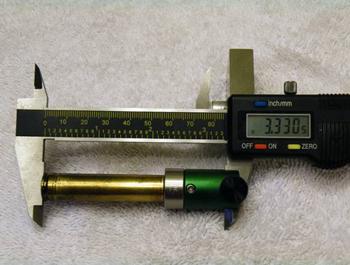
So now that we know this length of the fired case, we set up the resizing die in the press to "bump" the shoulder back to three thousandths of an inch (.003") under/shorter than this length. This gives clearance for loading and unloading the unfired round, but maintains a snug fit in the chamber so the round and bullet is held on centerline with the bore for ultimate accuracy. It also keeps us from over working brass. If we size the brass way back only for it to stretch way out on firing over and over, in just a few firings the brass case will separate from the head!
Here we can see from the original measurement that we have moved or "bumped" the shoulder back .003":
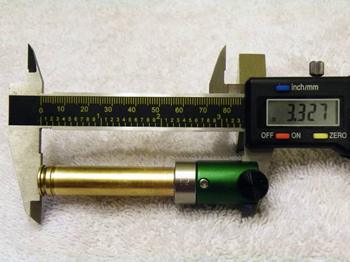
Until you get the tool in the mail you can improvise: take a fired case and wipe it off with a rag & alcohol etc. Use a candle or lighter and burn black soot onto the shoulder of the case.
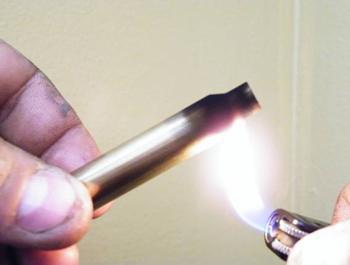
Back out your resizing die a few turns on the press. Press the case up into the resizing die and withdraw it. Did you get lines on the shoulder of the case? No? Thread in the die a little more and repeat. Continue this process until you get the very faintest lines in the soot.
In this photo you can see the line in the soot where the neck bushing stopped on the neck, as well as a (heavy, for the sake of the camera) line and some dappled marks where the shoulder was just touched by the resizing die:
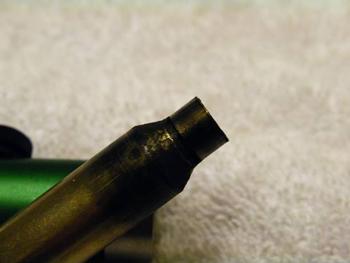
Primer pocket uniforming cuts all the primer pockets to exactly the same depth, in the name of consistent and uniform ignition. Here are the tools, a cleaned and uniformed pocket and the bulk of the material that was removed:
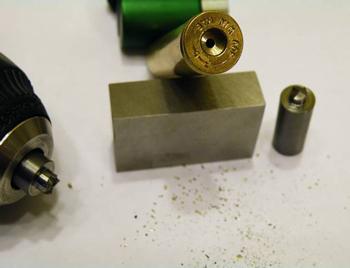
Deburr the Flash Holes
The flash hole is the hole in the head of the case that the sparks pass through to ignite the powder. In the manufacturing process this hole is not drilled. It is punched and that generally leaves a burr on the inside, or the whole "flap" of metal that was punched out. This can shield a portion of the powder from the sparks and lead to inconsistent ignition case to case. A deburring tool does just that. It cleans up the powder side of the flash hole for consistent ignition. The particular tool depicted here has the depth preset so the cutter (a common center drill) can only cut so deep into the flash hole:

All the mail order companies and most local shops carry these simple tools. A primer pocket uniformer can be used after each firing to clean the carbon out of the pocket. But you should revisit the primer pockets of your cases at least every three firings or so depending how hot your load is, as the brass flows with each shot, and they will eventually no longer be uniformed.
Trim to Length
Upon firing of the loaded round the case greatly softens and inflates like a balloon to fill the chamber of the weapon. This seals the chamber and prevents gas leaks, etc. But with the brass nearing a liquid ("plastic") state, it flows with the pressure of the propellant gas. Hence, as stated before, our primer pocket is not staying uniform. The overall length of the case grows and the mouth of the case typically thins at the very edge, as well as a "donut" eventually developing at the juncture of the shoulder and neck. Your reloading manual will give you the nominal "trim to length" measurement of a given cartridge case. So place said case in your case trimmer and trim it back to this specification. Correct? No.
NO!!! We are precision shooters for crying out loud. I have a friend that mows every case he gets his hands on back to minimum length, and it gripes me to no end.
Historically and generally speaking, the classic ultra accurate cartridges of the bench rest environment have longer than normal case necks. The typical case neck for a given cartridge is one caliber wide. Example: a 308 Winchester's bullet is a diameter of .308" so therefore the rule of thumb is that the mouth of the case should be "about" .308" long minimum. This allows good bullet tension and support so our carefully assembled loaded round's bullet is sitting dead in line with the case's centerline, which is in line with the centerline of the bore. All this leads to good shooting and smiles. The more we hack back the case mouth, the less neck we have to make sure our bullet is held inline. And the benchrest cartridges I mentioned have caliber plus neck lengths for this reason.
So what do we do? If the case gets too long, it will engage the rifling at the same time the bullet tries, giving us a wild and very dangerous pressure spike. If we hack it back to bare minimum we may have given room for some small loss of accuracy, especially with rough handling of ammo in the field. But we HAVE TO maintain consistency from case to case for shot to shot.
The answer is to measure the chamber length in your individual rifle and stay trimmed back from that actual number. Small chamber plugs to get that measurement are sold by Sinclair and others. Here is one I whipped out on the lathe yesterday for 30 cal:
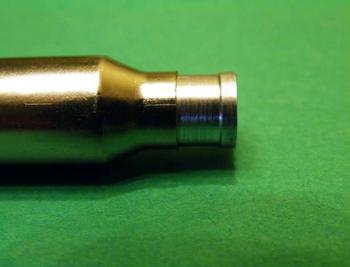
To use a gauge like this:
1. Thoroughly clean your weapons chamber.
2. Take a scrap case and trim it WAY back with your case trimmer, say .050" SHORTER than book spec.
3. Seat your plug gauge into the case - long.
4. Ease this round into your weapon and fully close and lock the bolt.
5. Remove the case gently without bumping the gauge. It has hit the end of the chamber and be pushed back into the case by the action of locking the bolt.
Measure the overall length of the case, head of the case to end of the plug, and note that measurement somewhere obvious and permanent in regards to loading for this particular rifle. It would probably be a good idea to repeat this measurement three times and average all three readings.
Now until this dimension changes (barrel removal, etc.), trim your brass just short of this measurement instead of "book trim to" specs.
Once we have our cases all trimmed to a uniform length for our specific rifle we now need to deburr the mouth of the case.
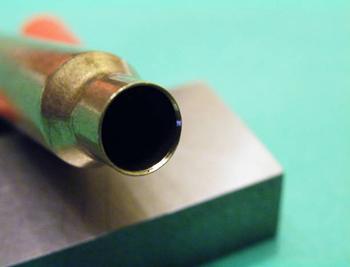
I'm sure anybody that is reloading knows what a deburring tool looks like for hand loading. Others: just do a Google search. Deburr the outside of the case just enough to remove the burr and put the slightest bevel on the edge of the case, the most minimal possible. As far as deburring the inside, gently cut a bevel on the inside of the case until it goes almost full diameter,that is the inside bevel almost cuts to the outside edge of the case mouth when looking from the end.
It is next to impossible to photograph, but you can see this inside chamfer is cut almost, but not all the way, to the outside edge of the case:
This is so that when we seat our precious bullet the opening of the mouth of the case does not cut, mar or peel back small portions of the soft bullet jacket.
And last but not least we need to prime our case. Practically every company that handles reloading components sells priming tools. For the wealthier individuals, I'd point you towards Sinclair International and those type suppliers. But a good job of priming can be done with lesser priced tools.
The main thing is that the tool have as much "feel" of the process as possible. You want to be able to clearly feel the primer bottom out in the primer pocket of the case, so you can keep the primers seated consistently case to case to case. This pre-loads the anvil of the primer the same for each round giving more uniform ignition shot to shot.
In the next chapter we will discuss how to inspect, sort and prep our bullets for a long journey.
Now wipe off the case and chamber the empty case in the rifle and see how the bolt feels as it closes. Was there any resistance? You want to bump the shoulder of the case back just enough that you're at the borderline of having/not having a teeny bit of resistance in closing the bolt on the case. Now you have your resizing die set as well as you can until the proper tool arrives in the mail.
Annealing
Brass work hardens. Shooting it, resizing it, tumbling it- it all hardens it. Which means some will be harder/stronger on their grip of the bullet than others and our consistency in everything we are trying to achieve went right out of the window. This example is known as "neck tension" or the amount of grip of the case neck on the bullet. Therefore we need to anneal our brass cases every 3 firings at least. I anneal mine every 2. You only anneal the neck and shoulder, NOT THE HEAD! There are fancy case annealing machines, but I don't have that kind of luxury. Here's what I do:
Purchase some 650 degree rated Tempilaq. Tempilaq basically looks like an oversized bottle of fingernail polish.
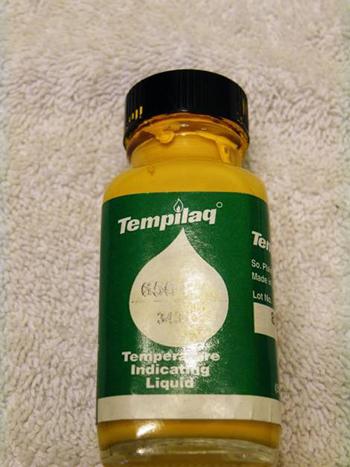
It comes in heat grades. We used it in machine shops for various tasks. You basically paint a stripe on your metal and let it dry. Apply heat and when it gets to the temperature you want the Tempilaq liquefies and the color (yellow) disappears.
I paint a stripe INSIDE the mouth of my cases.
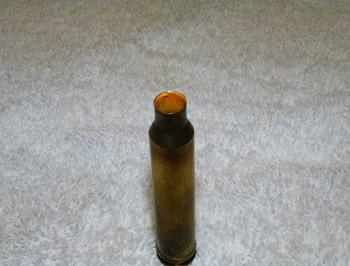
After it dries I hold the head of the case in my bare fingers and turn the mouth of the case in the flame of a propane torch. When my yellow paint of the 650 degree Tempilaq disappears, I drop the case in a bucket of water. Once all the cases are processed, we now have soft case mouths that will be uniform in neck tension on the bullet after they are loaded.
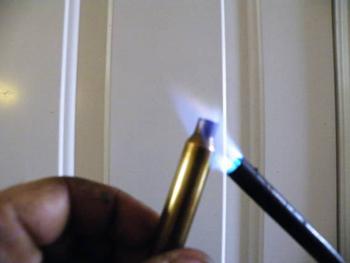
A word of caution: you never want the head of the case (the part that has writing on it) to get so hot you can't hold it. If you soften the head of the case you have created a very dangerous as well as troublesome situation. At the very least, you shoot the case (even a light load) and the primer falls out and it goes on from there with far greater personal risk/danger.
Cleaning
And while we are babying our brass, I do what many benchrest shooters have switched to: I use an ultrasonic cleaner to clean my brass. Vibratory tumblers only "prettify" brass. They do not clean the inside, the flash hole or the primer pocket. I do not care if the outside of my brass is shiny. As a long range shooter I need the inside, the flash hole and the primer pocket to be clean in the name of uniform combustion and burn, shot to shot. Also, all the rattling together of cases in the vibrator peens the cases together, hardening them all the more (although minimally.)
I suggest you purchase an ultrasonic cleaner on the cheap from Harbor Freight. Throw in your resized/deprimed cases. Cover the cases with distilled water. Then add 1 tablespoon of dish detergent as well as 3-6 tbsp of your favorite liquid brass cleaner - Birchwood-Casey, Lyman Turbo, etc. - any of the liquid products intended to be added into vibratory tumbling media.
Run the ultrasonic cleaner 20 minutes to an hour depending on the size and number of cases until they are totally clean on the inside and the primer pockets are all at least 95% clean. Rinse in bucket of about 5 gallons of distilled water and shake off. After they air dry or you hairdryer them, you're good to go. Tap water contains substances that can cause cartridge brass to oxidize. Stay with distilled.
[Note: After you clean your brass with your preferred manner, if you used Tempilaq to anneal them, you may need to use a bore brush to clean the burned tempilaq out of the case mouths. Make sure your case mouths are always clean in the name of consistent neck tension.]
Sorting
First, we'll continue by sorting all brass by brand. Then I sort it by weight. Everybody talks about Lapua & other premium brass being the best, but Winchester brass is at least 96% as good (and cheaper!)
Sort all your best brass cases into at least 2-grain lots. That is to say all of the cases in each batch of cases weigh within 2 grains of each other. This lets you know each case has about the same brass content. This tells us they are of the same average dimensions, which means we have the same sized combustion chambers case to case, giving us consistent muzzle velocity (MV) shot to shot.
Uniforming & Deburring the Flash Hole
Uniform all the primer pockets. Here's a dirty, uneven once-fired primer pocket:
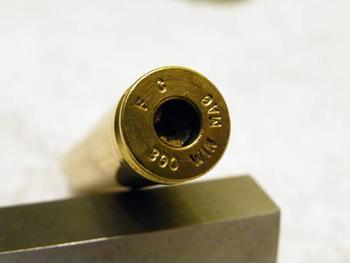
By Tres MonCeret
I have written an instructional article on some of the more advanced techniques of precision hand loading after teaching and answering questions on this subject time and time again. Many of these techniques are basic procedures in competitive bench rest shooting. We field shooters can squeeze all the more accuracy out of our equipment by incorporating many of these procedures even though we are not using zero tolerance rifles. However not ALL bench rest loading techniques nor ways of thinking are desirable for our purposes here as we are not on tidy cement benches, with "glued in" rifles having a specified neck dimensioned chambers and minimal tolerances throughout the weapon. Nor are our rifles or ammo protected entirely from dust, grit, rain as well as beats & bangs if not worse! In the following pages I explain the techniques I adapted from bench best competitive procedure that I feel are worthwhile and beneficial to the typical high-end field rifle & shooter.
Chapter 1: Brass Sort & Prep
Everything we do in hand loading is in the name of consistency, shot to shot. (Technically not "reloading" which is quick & expedient for the likes of short range speed shooting such as IPSC & Steel challenge shoots.)
So there it is before us - a fine specimen of a fired case. We need to resize our cases as well as deprime them. But before we do that, our case has a vital piece of information it's dying to give us.
When we resize the case we want it to stay a precision fit to the individual rifle's chamber from which it was fired. If we go ahead and resize it we have lost this information of the rifle's length of headspace. We need a tool for this.

We are going to measure the case from its head (where the writing is) to the datum of the shoulder. For this we need the above illustrated or similar tool from Sinclair International or other supplier. This device holds the insert onto your calipers. You'll also need the insert specific to your cartridge.
Here's a photo of the freshly fired case from the rifle being measured to obtain a headspace measurement:

So now that we know this length of the fired case, we set up the resizing die in the press to "bump" the shoulder back to three thousandths of an inch (.003") under/shorter than this length. This gives clearance for loading and unloading the unfired round, but maintains a snug fit in the chamber so the round and bullet is held on centerline with the bore for ultimate accuracy. It also keeps us from over working brass. If we size the brass way back only for it to stretch way out on firing over and over, in just a few firings the brass case will separate from the head!
Here we can see from the original measurement that we have moved or "bumped" the shoulder back .003":

Until you get the tool in the mail you can improvise: take a fired case and wipe it off with a rag & alcohol etc. Use a candle or lighter and burn black soot onto the shoulder of the case.

Back out your resizing die a few turns on the press. Press the case up into the resizing die and withdraw it. Did you get lines on the shoulder of the case? No? Thread in the die a little more and repeat. Continue this process until you get the very faintest lines in the soot.
In this photo you can see the line in the soot where the neck bushing stopped on the neck, as well as a (heavy, for the sake of the camera) line and some dappled marks where the shoulder was just touched by the resizing die:

Primer pocket uniforming cuts all the primer pockets to exactly the same depth, in the name of consistent and uniform ignition. Here are the tools, a cleaned and uniformed pocket and the bulk of the material that was removed:

Deburr the Flash Holes
The flash hole is the hole in the head of the case that the sparks pass through to ignite the powder. In the manufacturing process this hole is not drilled. It is punched and that generally leaves a burr on the inside, or the whole "flap" of metal that was punched out. This can shield a portion of the powder from the sparks and lead to inconsistent ignition case to case. A deburring tool does just that. It cleans up the powder side of the flash hole for consistent ignition. The particular tool depicted here has the depth preset so the cutter (a common center drill) can only cut so deep into the flash hole:

All the mail order companies and most local shops carry these simple tools. A primer pocket uniformer can be used after each firing to clean the carbon out of the pocket. But you should revisit the primer pockets of your cases at least every three firings or so depending how hot your load is, as the brass flows with each shot, and they will eventually no longer be uniformed.
Trim to Length
Upon firing of the loaded round the case greatly softens and inflates like a balloon to fill the chamber of the weapon. This seals the chamber and prevents gas leaks, etc. But with the brass nearing a liquid ("plastic") state, it flows with the pressure of the propellant gas. Hence, as stated before, our primer pocket is not staying uniform. The overall length of the case grows and the mouth of the case typically thins at the very edge, as well as a "donut" eventually developing at the juncture of the shoulder and neck. Your reloading manual will give you the nominal "trim to length" measurement of a given cartridge case. So place said case in your case trimmer and trim it back to this specification. Correct? No.
NO!!! We are precision shooters for crying out loud. I have a friend that mows every case he gets his hands on back to minimum length, and it gripes me to no end.
Historically and generally speaking, the classic ultra accurate cartridges of the bench rest environment have longer than normal case necks. The typical case neck for a given cartridge is one caliber wide. Example: a 308 Winchester's bullet is a diameter of .308" so therefore the rule of thumb is that the mouth of the case should be "about" .308" long minimum. This allows good bullet tension and support so our carefully assembled loaded round's bullet is sitting dead in line with the case's centerline, which is in line with the centerline of the bore. All this leads to good shooting and smiles. The more we hack back the case mouth, the less neck we have to make sure our bullet is held inline. And the benchrest cartridges I mentioned have caliber plus neck lengths for this reason.
So what do we do? If the case gets too long, it will engage the rifling at the same time the bullet tries, giving us a wild and very dangerous pressure spike. If we hack it back to bare minimum we may have given room for some small loss of accuracy, especially with rough handling of ammo in the field. But we HAVE TO maintain consistency from case to case for shot to shot.
The answer is to measure the chamber length in your individual rifle and stay trimmed back from that actual number. Small chamber plugs to get that measurement are sold by Sinclair and others. Here is one I whipped out on the lathe yesterday for 30 cal:

To use a gauge like this:
1. Thoroughly clean your weapons chamber.
2. Take a scrap case and trim it WAY back with your case trimmer, say .050" SHORTER than book spec.
3. Seat your plug gauge into the case - long.
4. Ease this round into your weapon and fully close and lock the bolt.
5. Remove the case gently without bumping the gauge. It has hit the end of the chamber and be pushed back into the case by the action of locking the bolt.
Measure the overall length of the case, head of the case to end of the plug, and note that measurement somewhere obvious and permanent in regards to loading for this particular rifle. It would probably be a good idea to repeat this measurement three times and average all three readings.
Now until this dimension changes (barrel removal, etc.), trim your brass just short of this measurement instead of "book trim to" specs.
Once we have our cases all trimmed to a uniform length for our specific rifle we now need to deburr the mouth of the case.

I'm sure anybody that is reloading knows what a deburring tool looks like for hand loading. Others: just do a Google search. Deburr the outside of the case just enough to remove the burr and put the slightest bevel on the edge of the case, the most minimal possible. As far as deburring the inside, gently cut a bevel on the inside of the case until it goes almost full diameter,that is the inside bevel almost cuts to the outside edge of the case mouth when looking from the end.
It is next to impossible to photograph, but you can see this inside chamfer is cut almost, but not all the way, to the outside edge of the case:
This is so that when we seat our precious bullet the opening of the mouth of the case does not cut, mar or peel back small portions of the soft bullet jacket.
And last but not least we need to prime our case. Practically every company that handles reloading components sells priming tools. For the wealthier individuals, I'd point you towards Sinclair International and those type suppliers. But a good job of priming can be done with lesser priced tools.
The main thing is that the tool have as much "feel" of the process as possible. You want to be able to clearly feel the primer bottom out in the primer pocket of the case, so you can keep the primers seated consistently case to case to case. This pre-loads the anvil of the primer the same for each round giving more uniform ignition shot to shot.
In the next chapter we will discuss how to inspect, sort and prep our bullets for a long journey.
Now wipe off the case and chamber the empty case in the rifle and see how the bolt feels as it closes. Was there any resistance? You want to bump the shoulder of the case back just enough that you're at the borderline of having/not having a teeny bit of resistance in closing the bolt on the case. Now you have your resizing die set as well as you can until the proper tool arrives in the mail.
Annealing
Brass work hardens. Shooting it, resizing it, tumbling it- it all hardens it. Which means some will be harder/stronger on their grip of the bullet than others and our consistency in everything we are trying to achieve went right out of the window. This example is known as "neck tension" or the amount of grip of the case neck on the bullet. Therefore we need to anneal our brass cases every 3 firings at least. I anneal mine every 2. You only anneal the neck and shoulder, NOT THE HEAD! There are fancy case annealing machines, but I don't have that kind of luxury. Here's what I do:
Purchase some 650 degree rated Tempilaq. Tempilaq basically looks like an oversized bottle of fingernail polish.

It comes in heat grades. We used it in machine shops for various tasks. You basically paint a stripe on your metal and let it dry. Apply heat and when it gets to the temperature you want the Tempilaq liquefies and the color (yellow) disappears.
I paint a stripe INSIDE the mouth of my cases.

After it dries I hold the head of the case in my bare fingers and turn the mouth of the case in the flame of a propane torch. When my yellow paint of the 650 degree Tempilaq disappears, I drop the case in a bucket of water. Once all the cases are processed, we now have soft case mouths that will be uniform in neck tension on the bullet after they are loaded.

A word of caution: you never want the head of the case (the part that has writing on it) to get so hot you can't hold it. If you soften the head of the case you have created a very dangerous as well as troublesome situation. At the very least, you shoot the case (even a light load) and the primer falls out and it goes on from there with far greater personal risk/danger.
Cleaning
And while we are babying our brass, I do what many benchrest shooters have switched to: I use an ultrasonic cleaner to clean my brass. Vibratory tumblers only "prettify" brass. They do not clean the inside, the flash hole or the primer pocket. I do not care if the outside of my brass is shiny. As a long range shooter I need the inside, the flash hole and the primer pocket to be clean in the name of uniform combustion and burn, shot to shot. Also, all the rattling together of cases in the vibrator peens the cases together, hardening them all the more (although minimally.)
I suggest you purchase an ultrasonic cleaner on the cheap from Harbor Freight. Throw in your resized/deprimed cases. Cover the cases with distilled water. Then add 1 tablespoon of dish detergent as well as 3-6 tbsp of your favorite liquid brass cleaner - Birchwood-Casey, Lyman Turbo, etc. - any of the liquid products intended to be added into vibratory tumbling media.
Run the ultrasonic cleaner 20 minutes to an hour depending on the size and number of cases until they are totally clean on the inside and the primer pockets are all at least 95% clean. Rinse in bucket of about 5 gallons of distilled water and shake off. After they air dry or you hairdryer them, you're good to go. Tap water contains substances that can cause cartridge brass to oxidize. Stay with distilled.
[Note: After you clean your brass with your preferred manner, if you used Tempilaq to anneal them, you may need to use a bore brush to clean the burned tempilaq out of the case mouths. Make sure your case mouths are always clean in the name of consistent neck tension.]
Sorting
First, we'll continue by sorting all brass by brand. Then I sort it by weight. Everybody talks about Lapua & other premium brass being the best, but Winchester brass is at least 96% as good (and cheaper!)
Sort all your best brass cases into at least 2-grain lots. That is to say all of the cases in each batch of cases weigh within 2 grains of each other. This lets you know each case has about the same brass content. This tells us they are of the same average dimensions, which means we have the same sized combustion chambers case to case, giving us consistent muzzle velocity (MV) shot to shot.
Uniforming & Deburring the Flash Hole
Uniform all the primer pockets. Here's a dirty, uneven once-fired primer pocket:


